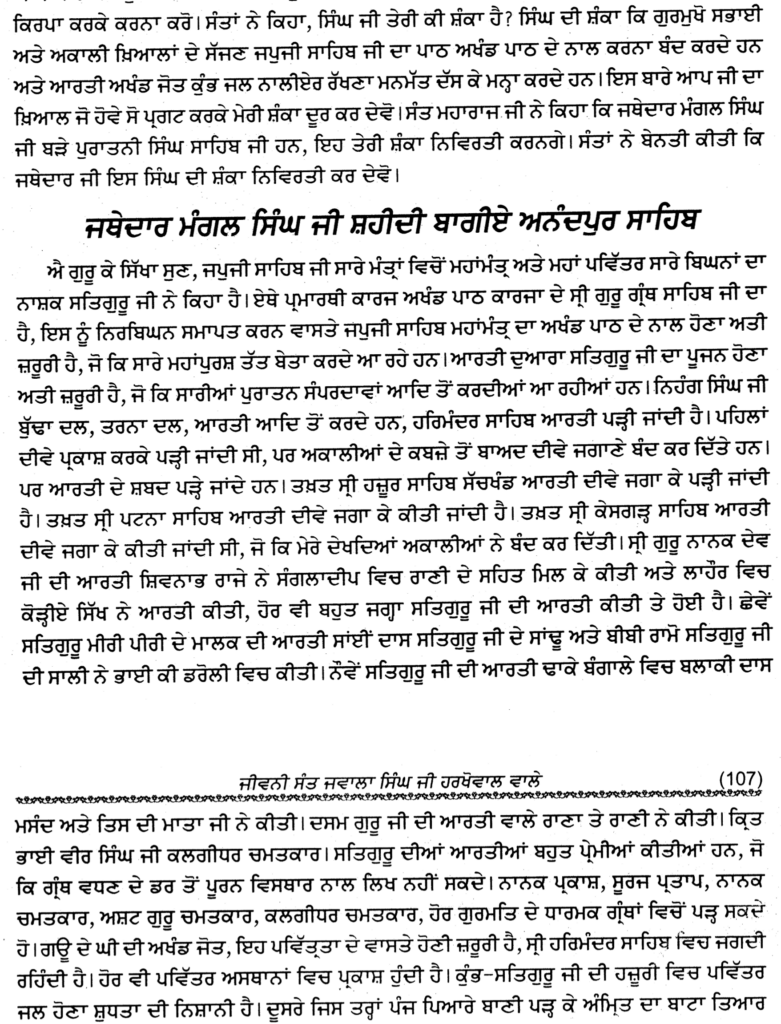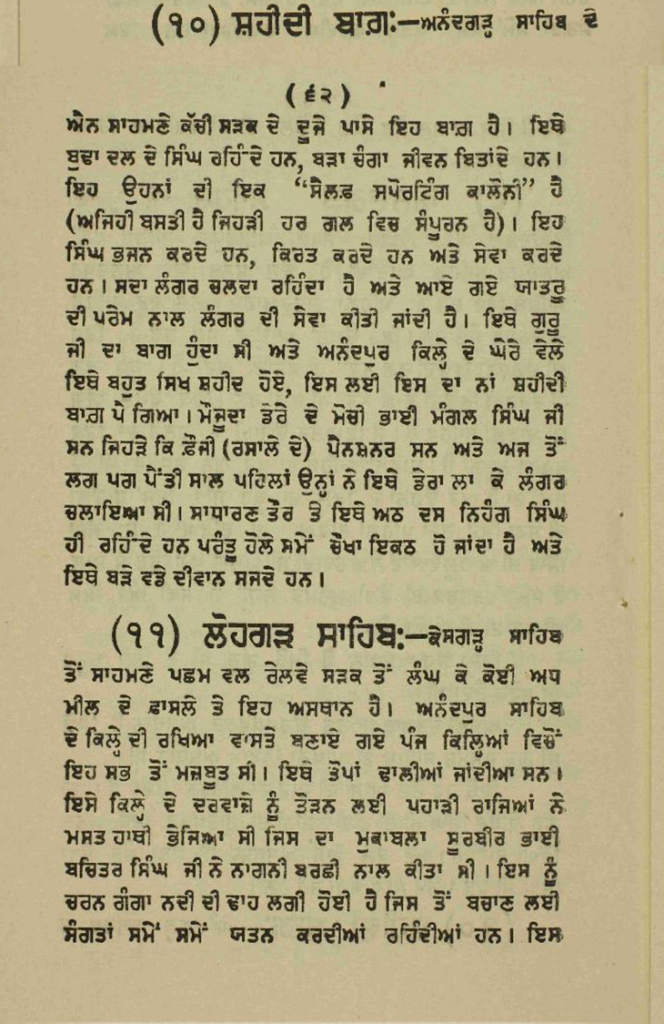Main Article: Aarti at Anandpur Sahib
Dera Sant Garh Harkhowal (founded by Sant Baba Jawala Singh Ji Harkhowal Wale) also upholds the tradition of Aarti (Link).
In Sant Ji’s biography titled “Jeevan Kirna Sant Baba Jvala Singh Ji Harkhoval”, an account is shared that highlights the importance of performing Aarti, lighting an Akhand Jot, and Kumbh Jal (Practices which SGPC’s Sikh Rehat Maryada has erroneously posited as “against Gurmat”). The account below is of a discussion between a Sikh and Jathedar Mangal Singh Ji (of Gurdwara Shaheedi Bagh Sahib), which took place in the presence of Sant Baba Jawala Singh Ji Harkhowal Wale.
Jathedar Mangal Singh Ji is also mentioned in the 1960 Edition of “Sri Anandpur Sahib Te Sambandit Gurudwareyan Da Itihas”.
An English Translation is given below! |
| Sant Baba Jawala Singh Ji, Harkhoval Wale (Dera Santgarh) (1889 CE – 1957 CE): Sant Ji [Baba Jawala Singh Ji, Harkhoval Wale] asked the Singh, “Singh Ji what doubt do you have?” The Singh’s doubt was that those who are Gurmukh-oriented and follow the ideology of the Akalis (the reformist Akalis*), prevent the Jap Ji Sahib prayer recitation which accompanies the Akhand Path prayer (a complete recitation of Guru Granth Sahib Ji). They also consider the [traditions of] performing Aarti, lighting an Akhand Jot (a continuously lit lamp), Kumbh Jal (placing water in a pot), and placing a coconut [in the presence of Guru Granth Sahib] to be Manmat (self-willed and against Gurmat) and try to dissuade people from doing these things. Please share what thoughts you have on this matter, and please help me clarify my doubts! Sant [Baba Jawala Singh Ji, Harkhoval Wale] Maharaj Ji replied that “Jathedar Mangal Singh Ji is a very Puratani [oriented] Singh Sahib. He will clarify your doubts. Sant Ji requested Jathedar Ji to remove the doubts of this Singh. [Chapter] Jathedar Mangal Singh Ji of Shaheedi Bagh Anandpur Sahib [Jathedar Mangal Singh Ji:] Hey Sikh of the Guru listen, Jap Ji Sahib Ji is the Maha Mantra (greatest Mantra) from all the Mantras and the greatest and most holy. [Jap Ji Sahib] according to what Satguru Ji has ordained is the destroyer of all obstacles. The Jap Ji Sahib Maha Mantar being done with the Akhand Path is of utmost importance for the affairs of spiritual knowledge and for the affairs related to doing the complete [Akhand Path of Guru Granth Sahib Ji] without interruption. This is what all the Mahapurush and truly knowledgeable ones have been doing up until now. [Ceremonial] worship of Satguru Ji alongside the Aarti [prayer] is of utmost importance, which all the Puratan Sampardas (schools/sects) have been doing right from the very beginning. Budha Dal and Tarna Dal of the Nihang Singhs have been doing Aarti (with lamps) right from the very start. Aarti is still read at Harimandir Sahib (“Golden Temple” of Amritsar) and in the past, the recitation was accompanied there by Deeva Parkash (the lighting/presentation of lamps in a plate). After the takeover of the holy shrine by the [Neo-Sikh reformist] Akalis, the lighting of lamps has been stopped, although the recitation of the Aarti Shabads still continues even today. At Takht Sri Hazur Sahib Suchkhand, Aarti is still maintained there with both the recitation and lighting of lamps. At Takht Sri Patna Sahib, Aarti is [also] maintained there with both the recitation and lighting of lamps. Aarti used to be performed by lighting lamps here at Takht Keshgarh Sahib [as well], and I have seen in my own lifetime, how it was stopped by the [reformist] Akalis. Raja Shivnabh along with his Rani (Queen) did Aarti of Sri Guru Nanak Dev Ji on the island of Sangladeep. In Lahore, the Kroriye Sikhs did Aarti, and in many other places Aarti was done and performed of Satguru Ji. Aarti of the 6th Guru, the master of Miri and Piri was done by Sai Das (Who was Guru Sahib’s Sandoo [husband of Guru Ji’s wife’s sister]), and Bibi Ramo (Who was Guru Sahib’s sister in law) in Bhai Ki Daroli. In Dakha Bangla[desh], Balaaki Das Masand and his mother did Aarti of the 9th Satguru [Guru Tegh Bahadur Ji]. Aarti of the 10th Guru was once done by an accomplished King and Queen. The incident is described in the work of Bhai Vir Singh Ji called Kalgidhar Chamatkar. Many devotees did Aartis of the Satgurus, all of the incidents would be too many to describe here. One can read about this themselves in Nanak Parkash, Sooraj Partap, Nanak Chamatkar, Asht Guru Chamatkar, Kalgidhar Chamatkar and other dharmic granths of Gurmat. * Historical literature employs the term “Akali” primarily for the Nihangs. The reformist groups [Lahore Singh Sabha/SGPC] seemed to have appropriated this term for themselves. |
ISBN: 81-7601-498-2 (Second Edition published in 2010 by: Sant Giani Jodh Singh Harkhowal & by: Sant Jagjit Singh Harkhowal [Sultanpur Lodhi])
From the Historical Gurdwaras of Anandpur Sahib today, Gurdwara Shaheedi Bagh Sahib stands out as one which still upholds elements of the Puratan Maryada of Anandpur Sahib and Takht Kesgarh Sahib.
| 1960 Edition – Sri Anandpur Sahib Te Sambandit Gurudwareyan Da Itihas |
 |
| English Translation of the Text Above: (10) Shaheedi Bagh: Right in front of Anandgarh Sahib, and across the unpaved road is this Bagh (Garden). The Singhs from Budha Dal stay here, who spend a good amount of their time here. This is one of their self-supporting colonies (it is such a settlement that is complete in every way). These Singhs meditate, work hard, and do Sewa. The Langar runs continuously and the traveler that visits is lovingly provided langar. This is the place where Guru Ji’s Bagh (Garden/Field) was located, during the time when the Anandpur Fort was besieged, many Sikhs obtained Shaheedi (were martyred) here, and due to this reason, this place came to be known as Shaheedi Bagh. Present day head of the Dera was Bhai Mangal Singh Ji, who was a [retired] military pensioner, and who set up a dera and started langar here approximately 35 years ago. Ordinarily one will find at least 8 to 10 Nihang Singhs [every day] here, but on Hola a large gathering takes place here and a big Diwan is set up. (Pages 61-62, Sri Anandpur Sahib Te Sambandit Gurudwareyan Da Itihas, Manager of Takht Sri Keshgarh Sahib Sri Anandpur Sahib, 5th Edition – November 1960] [The First Edition came out around/before 1948 CE]) |
Back to Main Article: Aarti at Anandpur Sahib